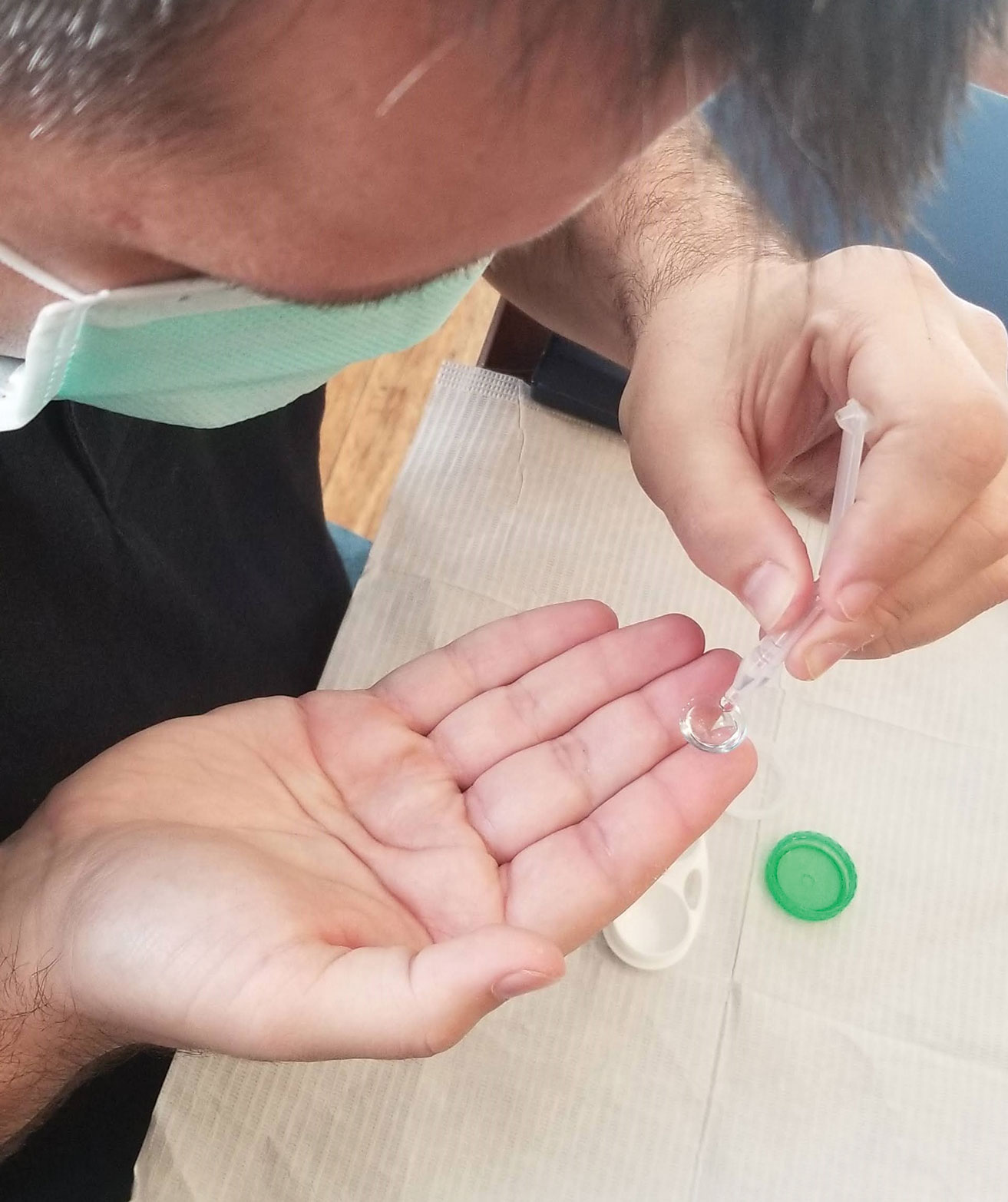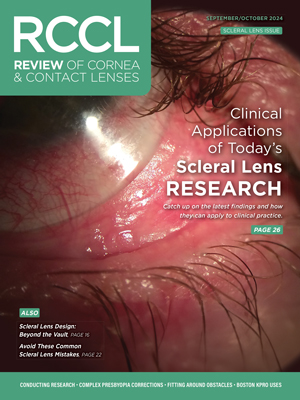 |
Having recently put together myriad virtual learning resources for my students on all things cornea and contact lenses amidst the COVID-19 pandemic, I was reminded of several key resources for online education. Many have compiled extensive information regarding COVID-19 and how it affects contact lens wearers as well as best practices for safe contact lens wear.
In light of the pandemic, some of the resources around disinfection and safety have become more crucial than ever for you and your patients to know. Included here are some that will help propel you forward during this uncertain time. It is worth noting that several of these sites also have contact lens education (webinars, continuing education, articles) specific to gas permeable (GP) and soft contact lenses in addition to the information related to the pandemic.
The AOA
The American Optometric Association (AOA) put together a website of coronavirus/COVID-19 crisis response resources for optometrists and their patients during the pandemic (www.aoa.org/coronavirus). One of the AOA’s popular offerings is a series of AskAOA webinars for practitioners to help navigate the pandemic in their offices, including special topics such as billing and coding for telehealth-based care and navigating Paycheck Protection Program loans. There are practice resources, including advice on what to do if someone in the office tests positive for COVID-19, as well as financial relief and support resources.
The AOA’s patient-facing COVID-19 resources include advice on proper handwashing before every contact lens insertion and removal.
The AOA’s site for contact lens health (www.aoa.org/contactlenshealth) contains information that was previously housed on contactlenssafety.org. Whether for my patients, coworkers or my students, I often turn to this resource to provide the citations behind the recommendations we make daily. There are four sections that I reference the most, collected together at the top of the sidebar: contact lens case care, lens care, purchasing and environments. Further contact lens fitting and training advice pertinent to the pandemic can be found at www.aoa.org/contact-lens-fitting-and-training-during-covid-toolkit.
 |
| A patient adds artificial tears to the bowl of a scleral lens while observing the in-office masking protocol. Patients receive an email before in-office appointments containing video training on application and removal of their particular lens type. Click image to enlarge. |
The AAO
The American Academy of Optometry (AAO) has a new resource right on its homepage called My COVID-Hub (www.aaopt.org/my-covid-hub), which is an up-to-date repository of clinical information related to the COVID-19 pandemic. The AAO appointed a COVID-19 task force early in the pandemic and has worked to assemble an extensive list of resources. There is a video series covering the most up-to-date information, including a donning and doffing of personal protective equipment (PPE) video, a clinical update and information on how COVID-19 can affect the eye.
The Academy’s COVID-19 Hub features over 25 “synopsis” documents that provide a research summary of relevant COVID-19 literature. There are also patient-facing resources that assist in identifying COVID-19-associated pink eye and provide patient education on what to do if someone thinks they have ocular sequelae.
Of note, the Hub also contain a printable version of the newest flow chart for in-office disinfection of multi-patient use contact lens. For GP lenses, the recommendation is to clean the lens with daily cleaner and then disinfect it for three or more hours in 3% ophthalmic-grade hydrogen peroxide in a non-neutralizing case. After the soak, the lens is rinsed with multipurpose solution, patted dry and stored.
The CDC
The Centers for Disease Control and Prevention (CDC) offer numerous resources, updated daily, regarding COVID-19 at (www.cdc.gov/coronavirus/2019-ncov/index.html). Regarding handwashing, there are several useful things here: www.cdc.gov/handwashing/when-how-handwashing.html. Specifically, the CDC’s “Clean Hands Count” campaign encourages healthcare providers to make hand hygiene a priority. On these pages, you can find downloadable posters, factsheets, brochures and other assets to help promote handwashing in your practice and on social media using the hashtag, #CleanHandsCount.
The CORE
A recent peer-reviewed paper from the Centre for Ocular Research and Education (CORE) published in Contact Lens and Anterior Eye draws attention to considerations for contact lens practitioners during the COVID-19 pandemic. The paper urges eye care practitioners to review optimal contact lens care behaviors and practices with patients, including: appropriate handwashing before both contact lens application and removal, appropriate daily cleaning and case care practices, avoidance of contact lens wear altogether if unwell (particularly with any cold or flu-like symptoms) and reminders about the option of moving to daily disposable lenses where applicable/appropriate.1
CORE’s top tips for contact lens patients during the pandemic, summarized in a one-minute video, at core.uwaterloo.ca/covid-19/ include:
- You can keep wearing contact lenses.
- Good hygiene habits are critical.
- Regular eyeglasses/spectacles do not provide adequate protection.
- Keep unwashed hands away from your face.
- If you are ill, temporarily stop wearing your contacts and use your glasses instead.
The Contact Lens Update website (contactlensupdate.com) is also produced by CORE. The site’s COVID-19 Special Edition Issue, published in March 2020, contains insight regarding the pandemic for both practitioners and patients.
One special resource available there is a set of four printable brochures that eye care practitioners can download and distribute to patients.
The BCLA
The June issue of Contact Lens and Anterior Eye, the journal of the British Contact Lens Association (BCLA), contains an article titled “Contact Lens Practice in the Time of COVID-19.”2
Other useful resources on the BCLA site (bcla.org.uk/public/public/consumer/contact-lens-wear-and-coronavirus-guidance.aspx) include advice on returning to practice and wearing gloves during a contact lens evaluation as well as two issued statements on contact lens wear: one geared toward eye care practitioners and the other toward consumers.
The GPLI
During the pandemic, extra webinars at the Gas Permeable Lens Institute (GPLI) were added on specialty GP lens fitting and maintaining best practices for contact lens safety during COVID-19 (www.gpli.info/). The most informative offering specifically related to the pandemic is a 90-minute special COVID-19 webinar titled “Today’s Contact Lens Challenges Bring Tomorrow’s Practice Advantages,” that features its executive director, Ed Bennett, OD, as moderator and panelists Jeffrey Sonsino, OD, and Susan Resnick, OD.
The GPLI has also gathered links to various contact lens practice-related and keratoconus-specific COVID-19 resources on its COVID-19 Resource Center: What to Know About Contact Lenses and Practice Reopening page at www.gpli.info/coronavirus/.
Across the Internet, there are many resources on COVID-19, but only select ones contain trusted information that can educate yourself, your staff and your patients. In a fast-changing situation like this global pandemic, it is prudent to ensure you are keeping up-to-date with the most current advice for soft lenses and GPs and seeking out that information from credible and professional regulatory bodies and government sources. Stay healthy!
| 1. Jones L, Walsh K, Willcox M, et al. The COVID-19 pandemic: important considerations for contact lens practitioners. Cont Lens Anterior Eye. 2020;43(3):196-203. 2. Zeri F, Naroo SA. Contact lens practice in the time of COVID-19. Cont Lens Anterior Eye. 2020;43(3):193-5. |


